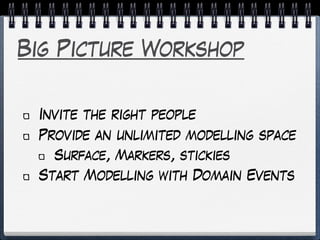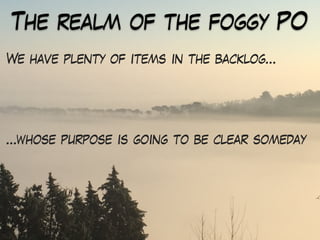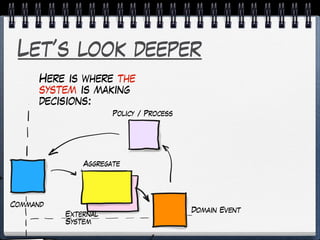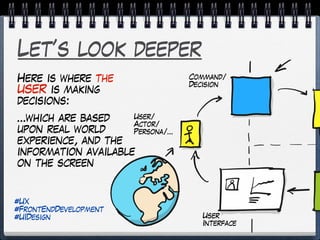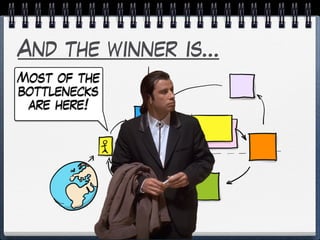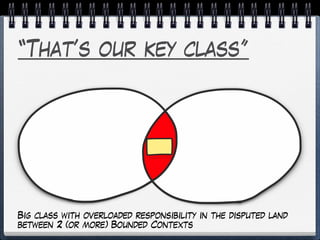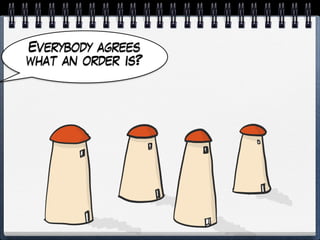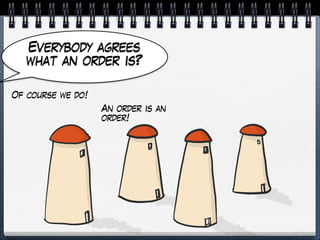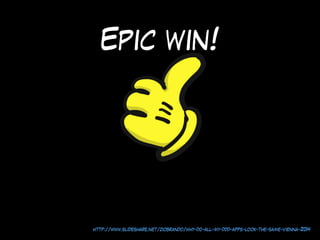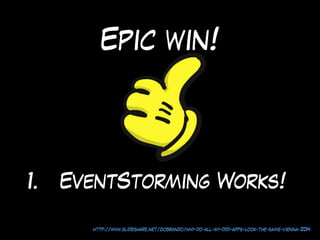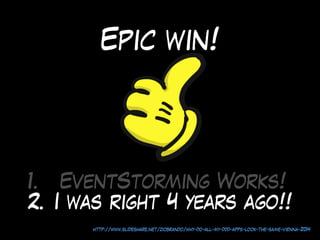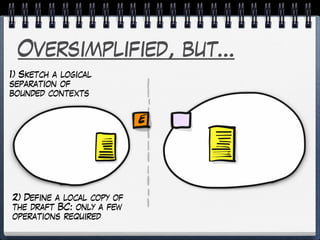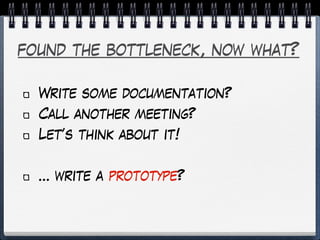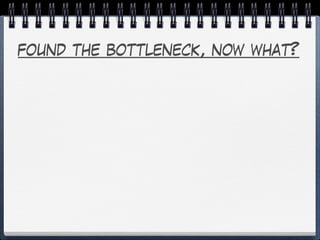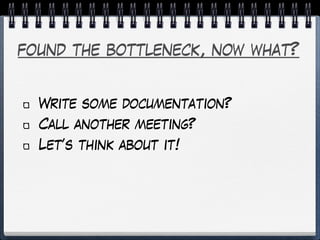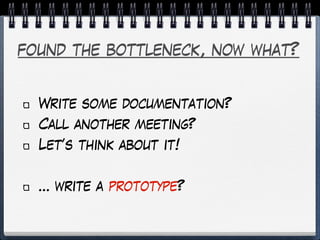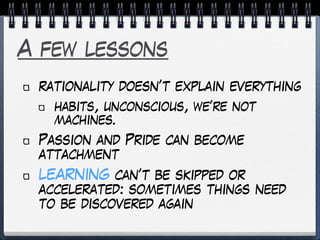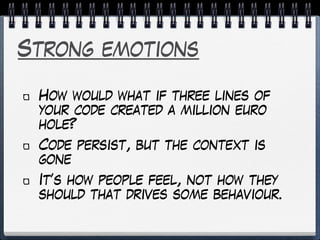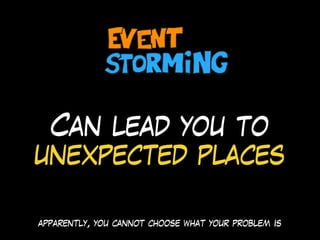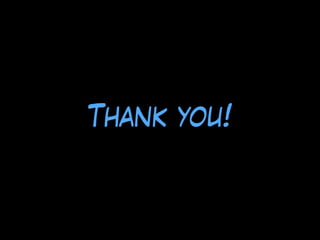What lies beneath
- 2. About me Very hard to explain my job to my mother running www.avanscoperta.it Modelling (almost) everything with sticky notes, markers and a paper roll. Calling this stuff
- 3. Quick recap of Focusing on Big Picture only
- 4. Big Picture Workshop Invite the right people Provide an unlimited modelling space Surface, Markers, stickies Start Modelling with Domain Events
- 6. Establish a timeline Some facilitator tricks will kickstart the discussion quickly
- 8. Capture Hotspots You won’t have to ask for problems… problems will find you!!
- 11. Outcome (big Picture): The whole process visible Massive learning Critical areas highlighted
- 12. More specifically… No scope limitation (paper roll) Exploration of boundaries (External Systems & People) -> The BOTTLENECK is in the picture. -> The CORE DOMAIN is in the picture
- 13. EventStorming blends lean and Theory of constraints into Software Development and Domain-Driven Design
- 14. EventStorming blends lean and Theory of constraints into Software Development and Domain-Driven Design
- 15. EventStorming blends lean and Theory of constraints into Software Development and Domain-Driven Design
- 16. Quick recap of Theory of Constraints Focusing on Bottleneck only
- 17. Bottleneck Main Constraint for a system throughput
- 18. Bottleneck strategies focus on it >>> Subordinate everything else improve it relentlessly small short term improvements will make a difference … while you work on long term improvements too
- 21. Can’t find the heart… yes, but look at these nails…
- 22. Improving anything but the bottleneck is close to meaningless Unless you have enough firepower to attack many problems at once..
- 23. The realm of the foggy PO We have plenty of items in the backlog… …whose purpose is going to be clear someday
- 24. What I’ll be speaking about and finally…
- 25. In the last 2 years Been EventStorming in many different situations Different domains large companies & small organisations Established business and startups …many different countries… …for different reasons…
- 26. Biases?? All the possible ones! I’ve seen only scenarios where I was invited…
- 27. What does a bottleneck look like?
- 28. Digging into the flow
- 29. Unrolling it… Business processes expose a repeatable structure
- 31. Let’s look deeper Aggregate Policy / Process Domain Event Command External System
- 32. Let’s look deeper Here is where the system is making decisions: Aggregate Policy / Process Domain Event Command External System
- 33. Let’s look deeper Here is where the system is making decisions: Simple local decision fit into Aggregates Aggregate Policy / Process Domain Event Command External System
- 34. Let’s look deeper Here is where the system is making decisions: Simple local decision fit into Aggregates Aggregate Policy / Process Domain Event Command External System
- 35. Let’s look deeper Here is where the system is making decisions: Simple local decision fit into Aggregates More complex & Reactive decision making fits into policies/Processes Aggregate Policy / Process Domain Event Command External System
- 36. Let’s look deeper Here is where the system is making decisions: Simple local decision fit into Aggregates More complex & Reactive decision making fits into policies/Processes Aggregate Policy / Process Domain Event Command External System
- 37. Let’s look deeper Here is where the system is making decisions: Simple local decision fit into Aggregates More complex & Reactive decision making fits into policies/Processes Aggregate Policy / Process Domain Event Command External System #BusinessProcesses #Transactions #SWArchitecture
- 39. Let’s look deeper Here is where the USER is making decisions: Command/ Decision User/ Actor/ Persona/… User Interface
- 40. Let’s look deeper Here is where the USER is making decisions: …which are based upon real world experience, and the information available on the screen Command/ Decision User/ Actor/ Persona/… User Interface
- 41. Let’s look deeper Here is where the USER is making decisions: …which are based upon real world experience, and the information available on the screen Command/ Decision User/ Actor/ Persona/… User Interface #UX #FrontEndDevelopment #UIDesign
- 42. Let’s look deeper Domain Event Read Model User Interface
- 43. Let’s look deeper Domain Event Read Model User Interface Here is were we transform raw data into readable meaningful information
- 44. Let’s look deeper Domain Event Read Model User Interface Here is were we transform raw data into readable meaningful information #BusinessIntelligence #Readability
- 45. And the winner is…
- 46. And the winner is… Most of the bottlenecks are here!
- 47. Most of the bottlenecks are here! And the winner is…
- 48. Most of the bottlenecks are here! And the winner is…
- 49. But we’re observing the effect, not the cause
- 51. Annoying anti- patterns in Legacy code
- 52. The Big Ball of Mud
- 54. “That’s our key class”
- 55. “That’s our key class” Big class with overloaded responsibility in the disputed land between 2 (or more) Bounded Contexts
- 57. Everybody agrees what an order is?
- 58. Everybody agrees what an order is? Of course we do!
- 59. Everybody agrees what an order is? Of course we do! An order is an order!
- 60. Everybody agrees what an order is? Of course we do! An order is an order! And has a customer too!
- 61. Everybody agrees what an order is? Of course we do! An order is an order! And has a customer too! Agreed!
- 62. Perfect recipe: Talk with many people Model Data-First (everybody agrees on nouns) Add some “Dogmatic DRY principle” Repeat
- 63. The Big Ball of Mud
- 64. The Big Ball of Mud I swear it was a monolith last time I checked!!!
- 65. The solution
- 66. The solution A Draft Model with loose integrity constraints
- 67. The solution A Draft Model with loose integrity constraints Constraints implemented as warnings
- 68. The solution A Draft Model with loose integrity constraints Constraints implemented as warnings A Validation barrier (constraints implemented as blockers)
- 69. The solution A Draft Model with loose integrity constraints Constraints implemented as warnings A Validation barrier (constraints implemented as blockers) An Execution Model, with similar data structure, but different behaviour
- 71. Epic win! 1. EventStorming Works! http://www.slideshare.net/ziobrando/why-do-all-my-ddd-apps-look-the-same-vienna-2014
- 72. Epic win! 1. EventStorming Works! 2. I was right 4 years ago!! http://www.slideshare.net/ziobrando/why-do-all-my-ddd-apps-look-the-same-vienna-2014
- 74. Oversimplified, but… 1) Sketch a logical separation of bounded contexts
- 75. Oversimplified, but… 1) Sketch a logical separation of bounded contexts 2) Define a local copy of the draft BC: only a few operations required
- 76. Oversimplified, but… 1) Sketch a logical separation of bounded contexts 2) Define a local copy of the draft BC: only a few operations required 3) “Publish” the key event, with all the relevant data
- 77. Oversimplified, but… 1) Sketch a logical separation of bounded contexts 2) Define a local copy of the draft BC: only a few operations required 3) “Publish” the key event, with all the relevant data 4) Use the published data to instantiate a valid object in the execution BC
- 79. Oversimplification? This one is probably not the only dependency… Who knows what else can be there… …
- 80. Asymmetries
- 82. Whoever advocates LEGO as an analogy to software development hasn’t been doing much LEGO lately
- 83. LEGO Entropy laws Mixing LEGO boxes takes seconds separating LEGO boxes takes ages
- 84. Or, maybe, it just requires some time…
- 85. LEGO Entropy laws Mixing LEGO boxes takes seconds separating LEGO boxes takes ages Moving a few pieces is reversible… …until you forget Then you loose control and call it “a mess”
- 86. Identify the right bounded contexts as early as possible …model & linguistic boundaries only… In greenfield….
- 87. In brownfield…
- 88. In brownfield…
- 89. Boy Scout Rule: Leave the campground cleaner than you found it
- 90. The Big Ball of Mud
- 91. The Big Ball of Mud Look, a code smell!!!
- 92. The Big Ball of Mud Look, a code smell!!! I’ve found one too!!
- 93. The Big Ball of Mud Look, a code smell!!! I’ve found one too!! i’ve founds dozens of them!!
- 94. The Big Ball of Mud Look, a code smell!!! I’ve found one too!! i’ve founds dozens of them!! Let’s rename a few classes…
- 95. … it takes a lot of perseverance…
- 97. There’s asymmetry in payoffs too
- 99. Or, more explicitly… Evolution here will have a lot less ripple effects… a safer place to improve!
- 100. Or, more explicitly… Evolution here will have a lot less ripple effects… a safer place to improve! And here situation is better too…
- 101. Or, more explicitly… Evolution here will have a lot less ripple effects… a safer place to improve! And here situation is better too… 1) we are reducing the number of people related to a model
- 102. Or, more explicitly… Evolution here will have a lot less ripple effects… a safer place to improve! And here situation is better too… 1) we are reducing the number of people related to a model 2) we are driven by business, not by smells
- 103. Smell is a good driver if you have no idea where the money is
- 104. Refactoring danger zone In code: Dependencies Compiler Tests In the database A lot harder to know who will be affected
- 105. It’s not the cleanup, it’s the associated risk It takes only one violation to get into “We have no idea” zone
- 107. Unclear payoff -> Risk avoidance clear payoff -> Risk Management
- 108. What happens when you discover the bottleneck? …maybe not what you expected…
- 110. found the bottleneck, now what?
- 111. found the bottleneck, now what? Write some documentation?
- 112. found the bottleneck, now what? Write some documentation? Call another meeting?
- 113. found the bottleneck, now what? Write some documentation? Call another meeting? Let’s think about it!
- 114. found the bottleneck, now what? Write some documentation? Call another meeting? Let’s think about it!
- 115. found the bottleneck, now what? Write some documentation? Call another meeting? Let’s think about it! … write a prototype?
- 116. found the bottleneck, now what? Write some documentation? Call another meeting? Let’s think about it! … write a prototype? implementing a solution?
- 118. found the bottleneck, now what?
- 119. found the bottleneck, now what? Write some documentation?
- 120. found the bottleneck, now what? Write some documentation? Call another meeting?
- 121. found the bottleneck, now what? Write some documentation? Call another meeting? Let’s think about it!
- 122. found the bottleneck, now what? Write some documentation? Call another meeting? Let’s think about it!
- 123. found the bottleneck, now what? Write some documentation? Call another meeting? Let’s think about it! … write a prototype?
- 124. #protip schedule a free day after an EventStorming
- 125. But the scary thing is…
- 126. Some companies attacked the problem, some didn't
- 129. The Dungeon Master https://medium.com/@ziobrando/the-rise-and-fall-of-the-dungeon-master-c2d511eed12f#.rtbyh8uid (yes I am aware that this one is the Star Wars emperor)
- 131. A few lessons rationality doesn’t explain everything habits, unconscious, we’re not machines. Passion and Pride can become attachment LEARNING can’t be skipped or accelerated: sometimes things need to be discovered again
- 133. Strong emotions How would what if three lines of your code created a million euro hole? Code persist, but the context is gone It’s how people feel, not how they should that drives some behaviour.
- 134. Are people feeling safe in changing?
- 135. Do they have options? Legacy is whatever you’re afraid to change
- 136. Culture is a better asset than code Safety, Experiments, …and component size too!
- 137. Conclusions …maybe not what you expected…
- 138. Enables cross- perspective conversation Software design, User Experience, Business Modelling, Lean etc.
- 139. Can lead you to unexpected places apparently, you cannot choose what your problem is
- 140. Stop building monoliths I know you won’t … it’s for slideshare. ;-)
- 141. I wasn’t explicit enough
- 142. Data Centric applications are damaging your business I wasn’t explicit enough
- 143. Data Centric applications are damaging your business The only thing that keeps companies in the market is that competitors are in the same situation… I wasn’t explicit enough
- 144. There’s a recurring way out
- 145. And a recurring problem too #DungeonMaster
- 146. Stop ignoring the culture We are not rational human beings 24H/day Emotions are driving technical choices more than you think
- 147. Thank you!
- 148. References • www.eventstorming.com • EventStormers on Google+ • https://plus.google.com/u/0/communities/ 113258571348605620818 • LeanPub book in progress: • http://leanpub.com/introducing_eventstorming • Blog: • https://medium.com/@ziobrando • http://ziobrando.blogspot.com • Twitter: @ziobrando • Trainings & Workshop facilitation: • http://www.avanscoperta.it




